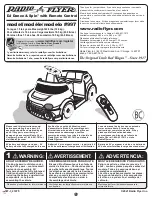
41
•
Batteries must not become damp or wet. The same applies for the charger that comes with the product.
The charger must only be used in dry, enclosed indoor areas. Moisture on the charger may cause a fatal
electric shock! The battery may also cause a fire or explosion!
Lithium rechargeable batteries (e.g. LiPo batteries) contain chemicals that are very sensitive to moisture!
•
Disconnect the drive battery from the model completely before connecting it to the charger. Never leave
the battery connected to a speed controller when it is charging. This may damage the charger, speed
controller or the battery! Always remove the battery from the model before recharging it.
• Place the charger and rechargeable drive battery on a non-flammable, heat-resistant surface (e.g. stone
tiles). Keep the charger and battery away from flammable objects. Maintain a sufficient distance between
the charger and the drive battery. Never place the drive battery on top of the charger.
•
Do not charge batteries when they are still hot (e.g. due to a high discharge current in your model). Allow
the battery to cool down to room temperature before charging it.
• Ensure that there is sufficient ventilation, as the battery and charger may heat up during the charging
process. Never cover the charger or the rechargeable battery!
•
Never leave batteries unattended when they are charging. Inspect the charger at regular intervals to
ensure that the battery is not overheating or expanding. If this is the case, it indicates an imminent risk
of a fire or explosion. If the battery overheats or starts to expand, disconnect it from the charger imme
-
diately and take it to a location where it will not cause any additional damage if it explodes or catches
fire (e.g. outdoors).
•
Disconnect the battery from the charger when it is fully charged.
•
Never damage the casing of a rechargeable battery.
• Never charge damaged, leaking or deformed batteries. This may cause a fire or explosion! Discontinue
use immediately and dispose of the battery in an environmentally friendly manner.
•
Rechargeable batteries should be charged regularly (approx. once every 2 - 3 months) to prevent them
from overdischarging. This may result in permanent damage and render the batteries useless.
LiPo batteries usually retain their charge for several months. However, if the batteries overdischarge, this
will result in permanent damage and render them useless.
b) Additional information about lithium rechargeable batteries
Modern lithium rechargeable batteries have a significantly higher capacity than NiMH and NiCd bat
-
teries and are also significantly more lightweight. This makes lithium batteries (especially Lithium
Polymer batteries) particularly suitable for use in model making.
However, LiPo batteries require particular care during charge/discharge, operation and handling.
The following sections provide an overview of the potential hazards associated with LiPo batteries
and explain how these hazards can be avoided to ensure a long lifespan for such batteries.
• The casing of many lithium batteries is made of one single thick film, which is very sensitive. Do not
dismantle, drop or insert any objects into lithium batteries. Do not apply mechanical loads or pull on the
battery’s connection cables. This may cause a fire or explosion!
Always observe these instructions when inserting or removing a battery from your model.
Summary of Contents for 2304801
Page 122: ...122 ...
Page 123: ...123 ...















































